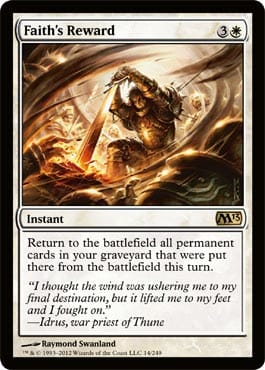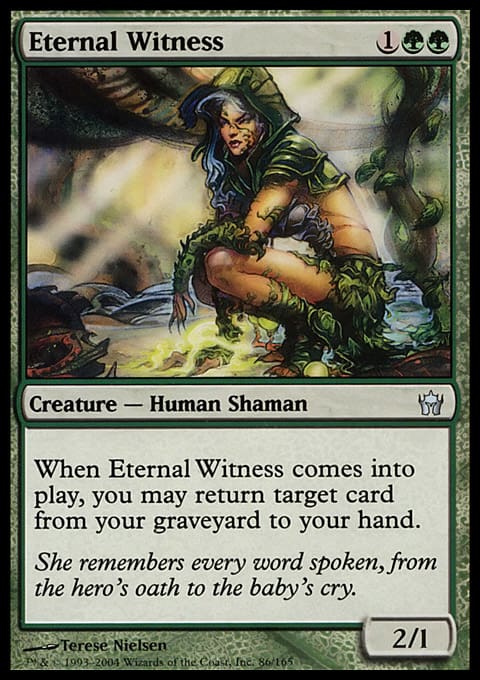In this experiment, we head to the Whisperwood and reward the Kobolds who are at our beck and call.
Last week, I wrote about how to use Fate Reforged’s forthcoming manifest mechanic to sneak creatures into play past their enters-the-battlefield abilities. This week, we use manifest in a different way, creating a swarm of tiny creatures, fueled by the previewed Whisperwood Elemental.

Every upkeep, Whisperwood Elemental manifests the top card of our library. Over time, that can generate a huge advantage. Indeed, I feel it will be a strong inclusion in my Karador, Ghost Chieftain Commander deck, as its ability virtually mills me in the same was as a Nyx Weaver does: Though it puts the card onto the battlefield instead of into my graveyard, “on the battlefield” is a very transient state in Commander, and I expect the manifested cards will quickly find their ways into my graveyard, where I expect Karador can make use of them. Alternatively, their presence in play offers me the ability to “cast” them from there (as long as they’re creatures, which many of them are).
But for today’s deck, we’ll be looking more toward the Elemental’s second superpower: the one that turns our defeated creatures into more manifestations.
Subtle Wording
As I contemplated Whisperwood Elemental while driving, I realized what an intense engine it could offer. Until end of turn, whenever one of our creatures dies, the Elemental’s ability will replace it with the top of our library as a 2/2—as long as we sacrificed the Elemental first, of course.
That meant we could sacrifice a creature, turn it face up—using manifest’s permission to turn face up a face-down creature for its mana cost—and then sacrifice that new creature to manifest another, and so on. In that way, we could create a virtual endless cycle of creatures.
I thought that seemed too good to be true. Wizards of the Coast doesn’t tend to create cards nowadays that have that kind of potential. So I decided to reread the card when I was no long in the state of precarious heavy-machinery operation.
And it was too good to be true. If the wording were something like the following, it would have worked.
However, the actual text is this:
See the subtle difference? In the first, hypothetical, case, the Elemental creates a rule-type game effect that alters all of reality for the rest of the turn. Any of our creatures that dies will trigger the rule. But in the second, actual, case, the Elemental gives a specific ability to our face-up, nontoken creatures, and abilities that do that kind of thing lock in at the time of resolution. That means once all our creatures given that ability die, we’re basically done for the turn.
Well, that was a bit disappointing, but it seems fair.
New Plan
But that doesn’t mean we’re done with Whisperwood Elemental. We can still make use of its noble sacrifice.
Consider Faith's Reward. If we sacrifice the Elemental and then sacrifice all our nontoken, face-up creatures, we can manifest that many more cards. Then, when we Faith's Reward, we’ll regain Whisperwood Elemental and the creatures we initially sacrificed, having gained a few more manifested creatures.
And how are we sacrificing the non-Elemental creatures? With Phyrexian Altar, we can be generating mana while we do so, and if one of the creatures we sacrificed was Eternal Witness, when we return it with Faith's Reward, we can also regain the Faith's Reward. That means we just need four creatures with the Whisperwood-granted ability, to give us 4 mana to recast Faith's Reward so we can repeat the process.
From that setup, we can manifest as much of our library as we want, generating more mana as we add more creatures to the cycle.
The Flaw
You may have noticed the flaw in the plan there, but don’t fret!
You see, as we manifest more cards, we’ll have to pay their mana costs in order to turn them from face-down creatures into face-up creatures. Since Whisperwood Elemental only grants the power to face-up, nontoken creatures, that’s a pretty important distinction. Our mana is already pretty tight, so we’re going to need some very cheap creatures manifested.
Fortunately, there’s a classification of creatures that perfectly fit our needs: those that cost 0 mana. With a large portion of our deck being dedicated to 0-mana creatures, when we manifest, we’ll be able to turn them face up for free, making them eligible candidates for the Whisperwood superpower, thus adding to our Phyrexian Altar–powered processing plant.
Having a deck full of 0-drops seems risky, as it can make our deck relatively impotent, but we can actually turn that to our advantage. With the powerful Glimpse of Nature and Beck // Call, we can create some strong turns during which we play a bunch of creatures and draw a bunch of cards in order to find our real combo pieces.
The 0-drops don’t do much damage, but an Overrun with a ton of manifestations can change all that.
Whisperwood Reward ? Casual | Andrew Wilson
- Creatures (24)
- 2 Eternal Witness
- 3 Crimson Kobolds
- 3 Crookshank Kobolds
- 4 Whisperwood Elemental
- 4 Memnite
- 4 Ornithopter
- 4 Phyrexian Walker
- Spells (16)
- 2 Summoner's Pact
- 3 Faith's Reward
- 1 Overrun
- 2 Beck // Call
- 4 Glimpse of Nature
- 4 Phyrexian Altar
- Lands (20)
- 4 Breeding Pool
- 4 Hallowed Fountain
- 4 Razorverge Thicket
- 4 Seaside Citadel
- 4 Temple Garden
How It Actually Works
So that’s the deck. Let’s take a look at a sample goldfish game to see the battle plan.
Turn one: We just play a Seaside Citadel. We have one to three 0-drops, but we don’t cast them.
Turn two: We play a Razorverge Thicket. We cast Glimpse of Nature and cast our 0-drops, drawing a card for each one. We may run out of fuel (free creatures to cast), but if we hit another Glimpse and still have a couple 0-drops, we cast that one, too, and then keep going. Our goal is to assemble the combo pieces we need (Whisperwood Elemental, Phyrexian Altar, Eternal Witness, Faith's Reward). We also need to hit our land drops through turn five. It may be optimal to hold off on Glimpse of Nature until we have a better idea of what we need and are closer to actually going off (to close windows for opposing removal spells), but for this example, we’ll go for it on turn two. We also may want to Glimpse on whatever turn it is if we need to find a land for that turn.
Turn three: We cast Phyrexian Altar.
Turn four: We cast Eternal Witness, perhaps returning Glimpse of Nature—or a dead 0-drop.
Turn five: We cast Whisperwood Elemental. Now we can go off. We sacrifice the Elemental and four creatures (including Eternal Witness), generating ![]()
![]() (or more). We manifest four times (or more) and Faith's Reward, returning the Elemental and the sacrificed creatures, having the Witness return Faith's Reward. Any of the manifested creatures that were 0-drops we turn face up, and then we sacrifice the Elemental again, followed by all our face-up, nontoken creatures, manifesting more, making more mana, and so on. We do this until we’re done giggling. At this point, we have our one Overrun either in our hand, on the battlefield as a 2/2, or in our graveyard somehow. If needed, we return it with an Eternal Witness or sacrifice it and then return it with Eternal Witness. Then, we pass the turn.
(or more). We manifest four times (or more) and Faith's Reward, returning the Elemental and the sacrificed creatures, having the Witness return Faith's Reward. Any of the manifested creatures that were 0-drops we turn face up, and then we sacrifice the Elemental again, followed by all our face-up, nontoken creatures, manifesting more, making more mana, and so on. We do this until we’re done giggling. At this point, we have our one Overrun either in our hand, on the battlefield as a 2/2, or in our graveyard somehow. If needed, we return it with an Eternal Witness or sacrifice it and then return it with Eternal Witness. Then, we pass the turn.
Turn six: We cast Overrun and attack with our library.
If you’re nostalgic for Crimson Kobolds, if you’re nostalgic for Caller of the Claw, or if you just like the idea of manifesting your library, give this deck a try.
Andrew Wilson
fissionessence at hotmail dot com


























